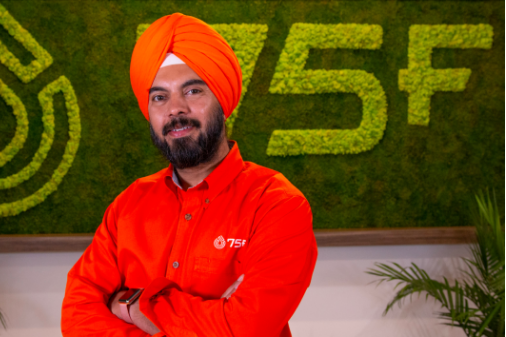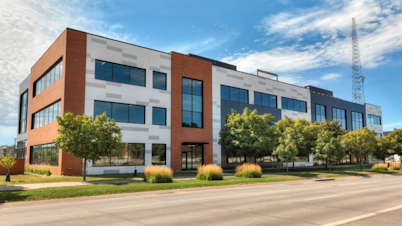
Saffron and the Smart Buildings Skills Gap
The 75F team and I just got back from AHR in Chicago. It was another great show for 75F, and our tenth since starting the company: We took home the Innovation Award in the building automation category for the HyperStat Split and had great conversations with many current and (perhaps) future customers.
The conference is the largest in the HVAC industry. Every serious HVAC vendor and controls competitor was there, along with mechanical and controls contractors, distributors and consultants, smart buildings integrators and consultants, engineers, architects, and building owners and facilities managers.
No matter who I connect with at shows like these, I always try to ask two questions to kick off a conversation:
What are you geeking out on or most excited about here at the show?
What do you see as the biggest constraint to your business today?
I love the first question because I’m a tech geek myself. When my wife and daughters are away for the weekend and I have the place to myself, you’ll find me reading up on ASHRAE cold weather sequences, research white papers, or new product specs (and yeah, I feel a bit embarrassed even typing that out).
Hearing what other executives or business owners are digging into is always diverse and interesting, but this year, most people at the show I talked two said exactly the same thing: AI.
Part of that was the context: This year at AHR we had live demos of 75F’s new Saffron AI. Visitors had a chance to walk up and ask questions or make changes to the actual 75F HQ in Minneapolis, all in real time and right from a laptop or mobile phone with Facilisight.
Letting people interact with a building for the first time is always a blast. They asked for and examined AHU performance data in a half dozen languages (at least that I could recognize). They adjusted temperatures in almost every office, sometimes a dozen times an hour (sorry 75F support team!). They created air quality alerts and energy savings reports and built lots and lots and lots of multisite performance reports.
While a few people told me it was their first time interacting with an AI themselves, almost everyone I spoke to inside or outside the show was using, following, or reading about AI. Many are exploring how AI can apply to their business or help unlock growth. There’s a long way to go, but the excitement around AI should be exciting to anyone who cares about the future of innovation or technology.
This brings me to my second question. What's your constraint.
What I heard over and over and over again isn’t supply chain shortages, or inflation, or returns to office.
It’s labor.
More specifically, the challenges today in recruiting and hiring and keeping and training skilled workers. Smart buildings have a massive skills gap.
This affects all building trades, but in building automation it's never been worse. I heard this from a franchise owner of a fast-food chain, a head of sustainability for a hospital system, a building owner for shopping centers, a facilities manager for an office building.
Controls contractors can’t find enough guys to fulfill demand. Mechanical shops and service teams are struggling to find controls contractors to pick up work. OEMs are offering higher and higher salaries. One exec shared that his company is offering relocation packages to find almost a dozen experienced controls techs and programmers on a multi-million dollar install. He didn't think he was going to meet the 2025 deadline.
Concerns about a shortfall in skilled labor should be the concern of anyone who cares about the future of innovation or technology.
Beyond sky-high wages and onboarding costs, this labor constraint hurts the entire HVAC industry by squeezing profit margins and increasing prices on needed building modernization or upgrades. It widens the gap between urban, class A customers who can pay for retrofit and new construction tradespeople, and suburban or rural businesses with slightly smaller buildings who cannot. It disproportionately effects entrepreneurs and immigrants and all light commercial customers — people in the 96% of buildings today smaller than 150,000 square feet — who spend a greater percentage of revenue on energy or maintenance. It disproportionately effects emerging markets too, where energy costs are high, populations are rising, and some of the worlds largest urban centers have only a handful of experienced system integrators or HVAC experts.
The skills gap is pushing energy efficiency or air quality upgrades out of reach for churches, for classrooms, for the municipal buildings in your hometown.
Everything I’ve read suggests this labor issue isn’t going away, either. Students aren’t going into trades, retirements are increasing, and extreme weather or cooling degree days make it harder and harder to deliver comfort.
Making the skills shortage so critical is that all over the world, our buildings are getting more complex, delivering more and more data.
Twelve years ago, I started 75F to eliminate heaters under desks and nagging occupant complaints. Six years ago, customers asked me if 75F could help them hit an energy or carbon target or add automated demand response for connected buildings on the grid edge. Three years ago, they wanted advanced air quality management and APIs capable of integrating access controls, people counters, or security data. Today, they are asking for all the above. Everything. And they want it to be affordable, intuitive, and easy to use.
You see where this is going?
The single most powerful insight from the AHR show this year is that the answer to the first question must be the answer to the second.
AI offers the single, clearest, most scalable path to addressing the labor gap in building automation.
And that’s why at 75F we built Saffron.
Roughly 90% of the world’s commercial buildings have no building automation system today. If we want to modernize, connect, or bring automation to these buildings, we need to look to new technologies; To new ways to leverage the workforce of today to realize the opportunities of tomorrow.
In short, if we want to grow our businesses without growing our teams – reach and manage systems in more buildings, reduce the costs and complexity of traditional analytics and reporting, or lower the costs for our customers – AI needs to be part of the answer.
Saffron AI is like having a super-smart assistant that understands each building inside out, predicting and adjusting to your needs. It's a new way to understand building data, and a new way to get things done.
Existing building automation systems can dial down the heat or taking advantage of free cooling, ensuring energy isn't wasted on empty floors or spaces. Sensors and machine learning algorithms today can continuously optimize indoor air quality, making adjustments on the fly for the health and comfort of everyone inside. But AI's like Saffron make smart buildings easy. Makes interfaces and graphs and nested dropdown menus totally disappear.
AI is the unlock to make tech work for non tech people. It hasn't hit it's first birthday yet and is already delivering value across the entire ecosystem. Eliminating truck rolls for a service team. Accelerating onboarding and familiarization for a facilities head or building engineer. Bringing not just alerts, but guidance to owners and users, guests and occupants.
What's most unexpected and exciting about this isn’t just how Saffron AI can help businesses with a labor constraint but how it is democratizing and scaling building technologies of all kinds.
For the first time, smart buildings aren't just elite, high-end skyscrapers. They are the nail salon, the day care, the neighborhood shopping center and grocery.
For the first time, we aren't just talking about using AI to generate a training manual, but about using it to eliminate the majority of the training altogether. About replacing web applications with voice interfaces, and advanced degrees and certifications with simple questions.
AI isn’t a small step in the future of controls, it's a giant leap for a smarter, more efficient world.
Forget about smart cities or buildings; we're talking about genius buildings. Buildings that think, learn, and adapt. Buildings that are not just structures but dynamic, responsive environments.
A critical solution to address skills gap is already here. It is available and installed in every 75F building around the world, right now. today.
An executive at a large equipment OEM described it like this to me (I'm paraphrasing a bit):
"If more smart buildings require more smart people, our thinking and ambition must also be limited. Linear. If we can bring computing power and practical affordable technology to the problem, if we can we start to design and build solutions that scale, we can make every building on earth better."
Thanks for listening. I look forward to the next conversation.
--Deep













